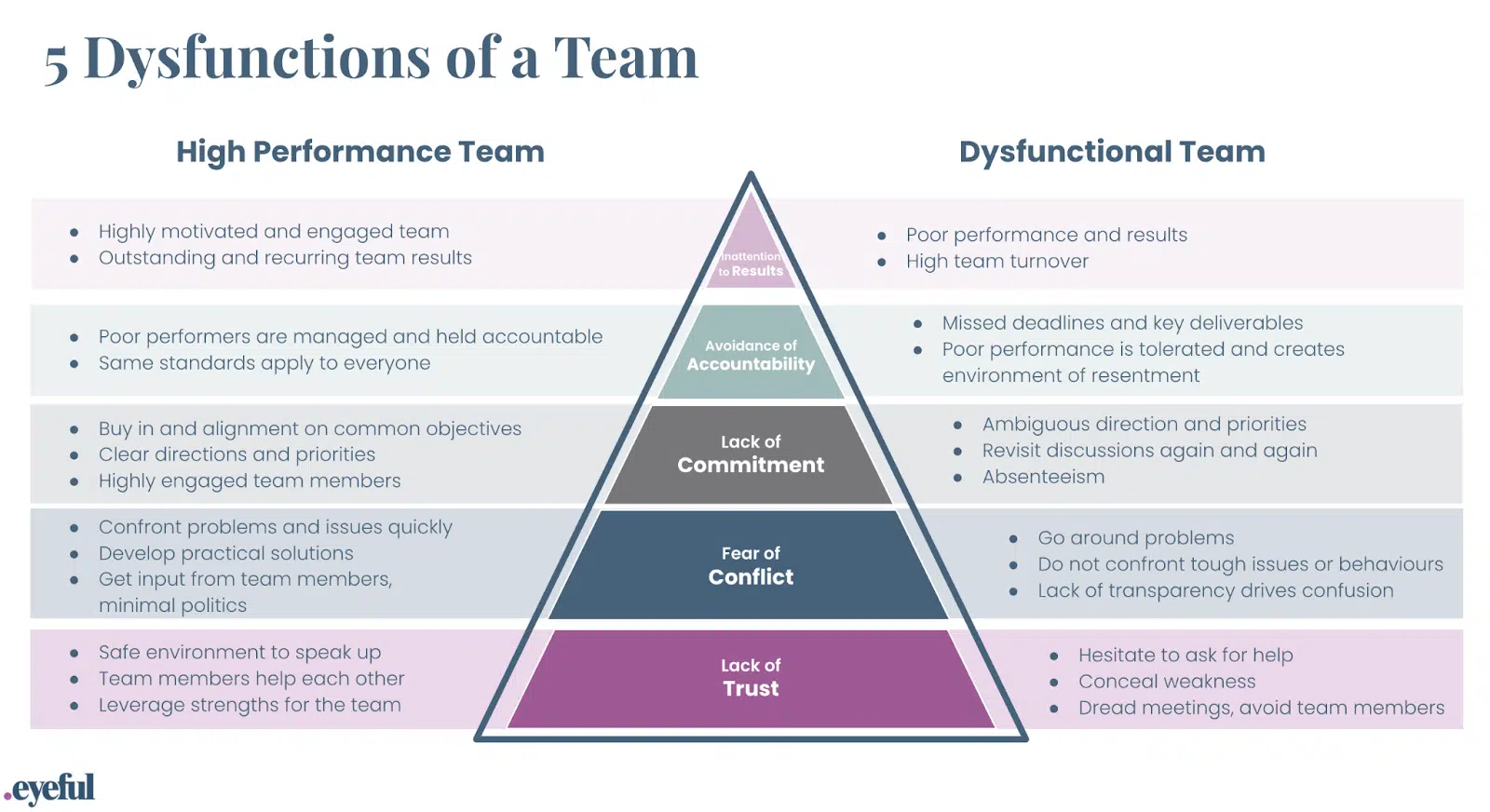Agencies have several teams, some of which are formed over the years and some that come together quickly as new hires join and new clients are onboarded.
Agency teams include executive leadership, marketing channel leaders and cross-functional groups or pods responsible for supporting clients.
With the complexity found in most agencies, it can be challenging to assess which are your highest-performing teams – or know what to do when one isn’t performing quite at the level you’d like.
Patrick Lencioni’s book, “The 5 Dysfunctions of a Team,” can serve as a framework for evaluating each team’s performance to identify areas of opportunity or find the most unified groups.
In summary, the model illustrates the five areas in which teams must thrive to become high-performing. The goal is to be highly functional by avoiding the five most common dysfunctions:
- Absence of trust.
- Fear of conflict.
- Lack of commitment.
- Avoidance of accountability.
- Inattention to results.
From leadership groups to pods, it’s essential to recognize the stage in which each team operates. Clients have high expectations, and to meet or exceed those expectations, building high-performing teams is critical.
Once a leader of an agency, division or client team recognizes how their team is operating, they can address the gaps to become exceptional.
We’ll start by exploring the lowest level – trust – since that is the foundational element of any high-performing team. All other facets and dimensions of this model are built upon trust and once that foundation is set, teams can begin to progress toward becoming the highest-achieving team possible.

Dysfunction 1: The absence of trust
If this dysfunction is present, people don’t feel comfortable being vulnerable, which prevents them from building trust with each other.
Without trust, moving up the pyramid and creating the optimal environment for high-performing teams is impossible.
In the absence of trust, you may notice some or all of the following: failure to get feedback, unpleasant or avoided meetings or politics.
Questions to consider
- Are team members slow to seek credit for their own work but point out the success of others?
- Do your colleagues open up about strengths and weaknesses?
- Do people speak up when they make mistakes and apologize?
Agency or team impact
If people don’t feel safe, they may not surface mistakes or concerns that could make them look bad. This could mean that issues are brushed under the table or linger longer than necessary.
How to begin to address it
Showing that vulnerability can be validated, instead of always negatively reinforced through punishment, is important. Build bonds by sharing something personal that others don’t know. The leader goes first so that it creates a safe space.
Dig deeper: Scaling an agency: Lessons of growth and change
Dysfunction 2: Fear of conflict
If this dysfunction exists, there’s generally a lack of healthy debate and discussion in meetings.
People may be more interested in keeping the peace than moving the ball forward. When there is a fear of conflict, meetings may be boring and little progress is made.
Questions to consider
- Do your team members openly give each other feedback?
- Are the most essential issues put forward in team meetings to be resolved?
- Is the team comfortable sharing their point of view?
- Do people debate issues to find the best answers?
Agency or team impact
If people aren’t comfortable with conflict, they may disagree with the direction handed down by leaders (or even a client) or suppress information that could improve campaigns or the business.
The lack of conflict also stifles innovation and growth, where an organic “third solution” is the best path forward.
How to begin addressing it
The leader of the pod or team should ask for differing opinions and state that healthy conflict is not only acceptable but encouraged.
Dysfunction 3: Lack of commitment
When this dysfunction is present, the team struggles to make commitments they will stick with. There is a lack of buy-in, and that generally leads to second-guessing.
Questions to consider
- Are team members aligned and willing to go the extra mile to ensure success?
- Are people committed to shared goals and understand how each person contributes?
- Does your team leave meetings confident that they are committed to the common goals and decisions, even if they weren’t aligned initially?
Agency or team impact
Anyone who has worked for an agency knows it’s fast-paced and important to get alignment on strategies, tasks/projects to complete and new processes.
When there’s a lack of commitment, the team doesn’t act as a unified front – which can lead to not finishing tasks or projects, insubordination or continuously revisiting the same topics.
How to begin addressing it
Set clear deadlines for key decisions and push for issue closure before the end of meetings. Ensure your team is using committed actions rather than just saying, “Sure, I’ll get it done.”
An example of a committed action response would be, “Yes, I’ll have that to you by Friday EOD” or “I can’t get it done by Friday EOD, but is it OK if I get it to you on Monday by noon.”
Dig deeper: How to build and maintain client trust in your agency
Dysfunction 4: Avoidance of accountability
When this happens, peers don’t hold each other accountable. Because doing so can be uncomfortable or awkward.
While agency life may not come to mind when thinking of this dysfunction, sports teams might – just imagine how the world’s best athletes must hold each other accountable.
Questions to consider
- Do team members end discussions with clear next steps and commitments?
- Is your team clear on relevant details and aligned on completion dates when they make and accept requests?
- Do they worry about the prospect of letting down their peers?
Agency or team impact
No one enjoys holding their peers’ feet to the fire, but in some of the highest-performing teams, that’s exactly what happens.
When working on accounts involving multiple team members, everyone must do their part – and sometimes, that requires calling people out when something drops.
If not, it can lead to resentment and frustration, as high performers don’t want to carry the load of their underperforming peers.
It also can lead to a lack of trust, which takes you back to step 1 or the lowest rung of the pyramid.
How to begin addressing it
Reward the team for achieving goals and clarify exactly what is expected from each team member and by when. Use clear requests to get desired results.
For example, instead of saying:
- “We could really use some fresh ideas…”
Make a clearer request, such as:
- “I want everyone to bring two new ideas to Thursday’s 3 o’clock meeting and be prepared to discuss them. Raise your hand if you will do that.”
Dysfunction 5: Inattention to results
When this dysfunction is present, people are more focused on their individual goals than the goals of the larger organization or team.
There is less focus on succeeding as a group, which may mean that most work is short-term focused and less attention is given to items that will take longer but perhaps make more of a long-term impact.
Questions to consider
- Do team members stay focused on proactive activities or are they spending most of their time on reactive ones?
- Does the team adequately balance short- and long-term goals to meet objectives?
- If there’s a goal set, does everyone take it seriously? Are people a little let down if goals are missed?
Agency or team impact
Juggling work for many clients can be taxing and require incredible time management skills.
Rather than paying attention to overarching team (or client) goals, teams focus on their part of the project or the task at hand without looking at the macro impact.
Essentially, it’s a form of looking at the trees but not considering the forest. This can lead to making a lot of changes to programs that are immaterial and don’t move the needle.
Similarly, for departments or leadership teams, it can lead to maintaining the status quo – not bad per se, but not as optimal as it could be.
How to address it
Have leaders set the tone about which results matter and commit publicly to the team’s goals.
Provide transparent goals, KPIs and data throughout teams. Having the same information makes it easier for everyone to align with common goals.
Eliminate dysfunction in agencies
As you look around you and consider the different teams within your organization or immediate peers, you may notice that each is operating in a slightly different stage of Lencioni’s 5 Dysfunctions.
Consider exploring this model with your most trusted peers to identify where to focus first to elevate your group’s and, ultimately, your client’s performance.
Dig deeper: How to build a values-based agency that drives results
Contributing authors are invited to create content for Search Engine Land and are chosen for their expertise and contribution to the search community. Our contributors work under the oversight of the editorial staff and contributions are checked for quality and relevance to our readers. The opinions they express are their own.








